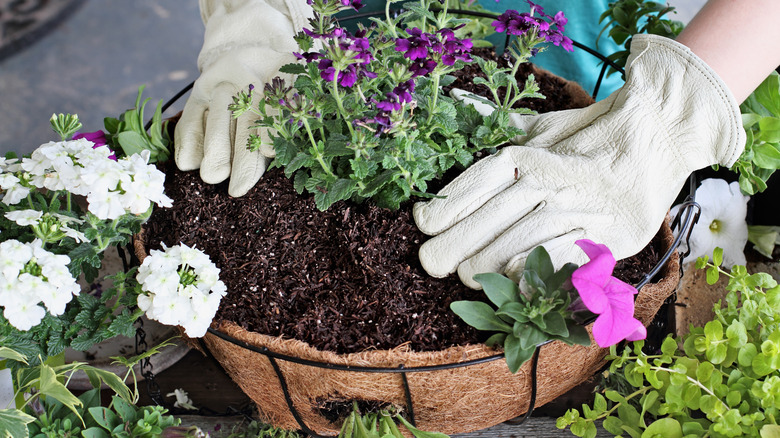How To Revive A Dying Hanging Basket
A colorful floral hanging basket is a simple, yet impactful way to add beauty to the landscape of your home. However, in order for your hanging basket to produce blooms and color all season long, it's important to properly care for it by ensuring it is getting plenty of water, as it can easily dry out after a few days without water.
In addition to easily becoming dry in the hot summer sun, hanging baskets are particularly susceptible to becoming root bound, especially smaller sized baskets. If your hanging basket arrangement has become root bound, it will be unable to absorb water and other vital nutrients from the soil, causing it to die if not repotted.
While your hanging basket plants becoming dehydrated or root bound can lead to them wilting and losing their color, don't automatically assume they are dead without first giving them the right amount of TLC. Many of the types of flowers commonly used in hanging baskets are chosen for their hardiness and ability to bounce back, so your dying basket may not be too far gone if you act quickly. By repotting your root bound hanging basket or thoroughly soaking it if it has become dried out, you can revive it before it fully dies.
If your hanging basket is dried out
If you forget to water your hanging basket for a few days and it's now majorly wilted and dried out, there's a chance it's still alive and just needs a drink and some additional care. The first step is to remove the hanging basket from direct sunlight so it can have a chance to recuperate without the risk of drying out even further. Saturate the soil completely, and continue to do so once a day, even after your plant bounces back. Completely saturating it until water begins to run out of the holes in the bottom will help ensure it stays hydrated all day long in the hot summer temperatures.
Once your hanging basket is revived, be mindful about not forgetting to water it going forward. Each time you let it dry out completely between waterings, you can do irreversible damage to the cells in the plant, diminishing its ability to be revived each time. Water your hanging basket in the morning, as this will give it the best chance at surviving the sun's harsh rays and peak temperatures of the day later on.
Keep in mind that if the temperatures are unusually high or it's extra humid outside, you may need to water twice a day. If your hanging basket is still being scorched by the hot sun, ensure you have it hanging in an area that receives the proper amount of sunlight depending on the type of plants you're growing.
If your hanging basket is root bound
While it can be tempting to purchase the fullest hanging basket with the most blooms, a basket with an abundance of color and open buds is an indication that it has been growing in its current container for a while. Though this makes for a beautiful display as soon as you take it home, it also means that there's a greater likelihood that the basket has become root bound, or is close to becoming so.
When your plant becomes root bound, its roots fill all the available space in the container. When this happens, water will have nothing to absorb into, meaning it will run directly out the bottom of the basket without reaching your plant. This is especially common in small hanging baskets, with popular sizes of 10 and 12 inches.
If your dying hanging basket is showing signs of being root bound, you should be able to revive it by planting it in a bigger basket with new soil to allow the roots the space to expand. When upgrading your basket, choose one that is at least 16 to 18 inches in diameter, as this will allow your plant the space it needs to grow and thrive all season long. Prior to replanting in a larger hanging basket, gently loosen the tightly bound root clusters with your fingers and soak them with water before filling with fresh potting soil. This will help them better take hold in the new soil.


